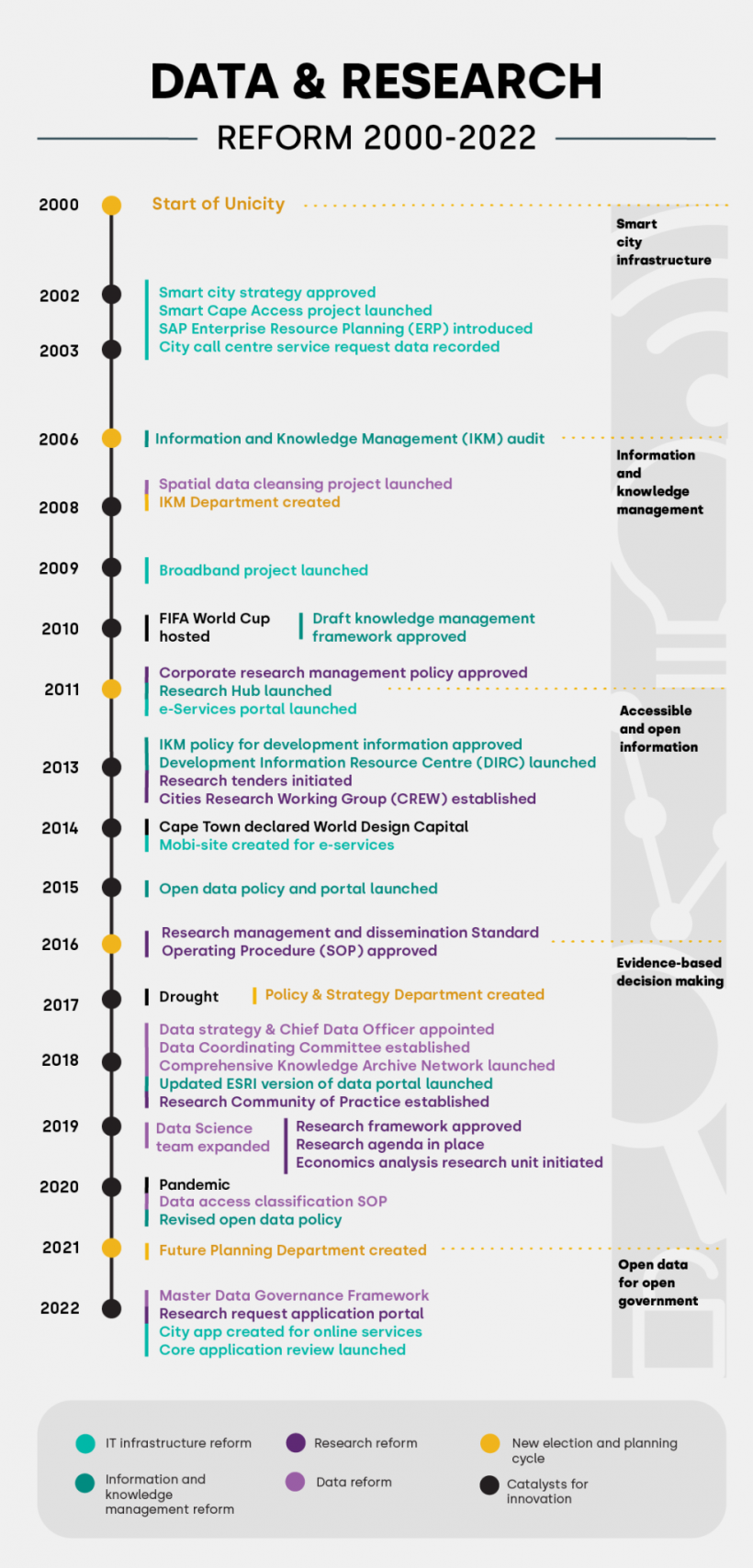
Data and research journey of a ‘smart city’: the City of Cape Town’s practical approach towards evidence-based decision-making
‘Smart Cities’ have the potential to leverage big data and advanced analytics to improve residents’ standards of living. Over 20 years, the City of Cape Town illustrates how cities can grow towards maturity in using data and research to improve city outcomes.
Data and research provide evidence from which local governments can make more informed decisions, improving efficiencies, resource allocation, and project evaluation. The use of data and research is often enabled by technology, and may be further improved through advanced analytics (such as machine learning and artificial intelligence).
Municipalities should only invest in technology in response to a clearly defined business need. This is illustrated by the City of Cape Town’s (CCT) data and research journey. It officially began in 2000, when seven disparate municipalities were merged into one UniCity. The new CCT was more complex to manage, requiring real time data to understand and manage its constituents. Business processes needed to be aligned; systems for automating, managing, and storing information needed to be sourced; and information and knowledge management principles needed to be accepted internally.
CCT’s progress, over two decades, is detailed in this case study . Here, we showcase the main components of building towards improved use of data and research in City outcomes.
Building the IT infrastructure for improved administration
The first phase of reform sought to ‘re-engineer’ the City’s business processes to prepare for the IT transformation in the early 2000s. The City began strategising about what a smart city might look like, and investing in IT infrastructure to bring the vision to life.
The organisation-wide Enterprise Resource Planning (ERP) system integration between 2001 and 2003 automated the City’s business processes, as called for by the 2002 Smart City Strategy. CCT’s business-led (as opposed to technology-led) approach enabled the systems to be responsive, improve business functions and revenue collection, and iteratively collect administrative data and information over the years.
Over time, however, the City became locked-in, unable to leverage more dynamic and novel systems that were being innovated. CCT is now grappling with the costs and benefits of migrating some of its core systems to alternative technologies.
Connecting the wider city and e-services
Alongside investing in internal systems, in order to fully leverage the benefits of technology, the City needed to ensure that citizens could engage digitally. Digitally-enabled citizens were also seen as a broader economic enabler, spurring job-creation and innovation. From 2002, the City developed projects with the concurrent goals of providing ICT access and communicating with citizens digitally through e-services.
The City monitored the risks posed by a shifting technological landscape, and considered its role in relation to the private sector in mitigating them. These regular reviews and stock-taking allowed the City to shift its core focus to improving service delivery through e-services, while ICT access projects continue under revised and adapted implementation strategies.
Adopting and enhancing information and knowledge management (IKM) practices
The development of IT infrastructure and citizen engagement systems created a need to better use and manage information. Following a 2006 IKM Audit which found siloed information management, the City’s goal was to take stock of what they know, and to use this knowledge to inform further decision-making.
Frameworks and policies were thus, iterated to provide guidance for a corporate approach to knowledge management. From 2011-2013, the City developed IKM platforms to share ‘one version of the truth’ and ‘official statistics’ for City officials to draw from.
As core IKM frameworks and internal data and research centralisation was making progress, the City embarked on the next phase of the journey: making the City’s data more accessible externally through an Open Data Portal supported and guided by an Open Data Policy in 2015.
Learning about how open data improved business functions and accountability in other cities disarmed internal resistance to data sharing. Certain City datasets were made public, free, and easily accessible, with data custodians from each department responsible for collating, publishing, and updating data on the portal.
Evidence-based decision-making
Years of standardisation and improved knowledge management generated large amounts of data, research, and information sets, which became City assets that support evidence-based decision-making. The 2017 Organisational Development and Transformation Plan (ODTP) catalysed a shift in organisational culture, towards customer-centric and responsive service delivery.
Policy is now linked to evidence, with measurable criteria for the evaluation of policy success.
Building on over a decade of data readiness work under IKM and Information Systems & Technology, the 2018 transversal data strategy gives direction and grounds for embedding data into City practices, enabling prediction and impact evaluation rather than only reporting.
The 2019 transversal research framework recognises that research should underpin all decision-making. It includes three Standard Operating Procedures, for managing the process of research, external research requests, and research partnerships, respectively. An internal, ‘living’ research agenda aligns City research activities with City priorities.
Investing in new skills and structures was also necessary to manage organisational change.
The City’s Data Strategy implementation plan created workstreams to prioritise its six pillars: sharing, partnerships, capabilities, architecture, governance, and value. The Data Coordinating Committee was established to govern the implementation of the data strategy, and the first Chief Data Officer was appointed to chair the committee. In 2019, the Data Science Unit was expanded to improve data analytics and systems capacities, making it more responsive to organisational and performance needs.
The Corporate Research Unit now aligns research with strategic objectives, and creates standardised processes for its management. The City also included a new mandate in its economic analysis unit to apply microeconomics tools to City decision-making.
Looking ahead
The new UniCity necessitated the integration and automation of business processes. By tracking business needs and global conditions, the City could invest in necessary in-house capacities for innovative projects, including ones to embed IKM principles organisation-wide and to connect with the wider city. Clear leadership and a flexible approach to emerging priorities brought CCT to mandate evidence-based decision-making through transversal policies, recognising data and research as its core foundation.
Throughout this series of developments, Cape Town’s ‘smart city’ ideals have remained practical and fit-for-purpose. Advanced technologies, big data, and predictive analytics, while useful in some cases, are not the main focus in the above reforms. Similarly, the City is now reviewing its core applications, such as the ERP system, to ensure the enabling technology is still fit-for-purpose, and incrementally updating the strategies and approaches above.
The new Mayor has placed great emphasis on the concept of ‘open data for open government’. This goes beyond opening the City’s data assets for research and entrepreneurship, to name a few, and now views open data as a springboard for transparency and accountability, as well as improving responsiveness to citizen needs.
Figure 1: Timeline of data and research reform in the City of Cape Town, 2000-2022.

To learn more, read the complete case study, view a message from the Mayor of Cape Town, and watch the project video and the other five accompanying videos.

